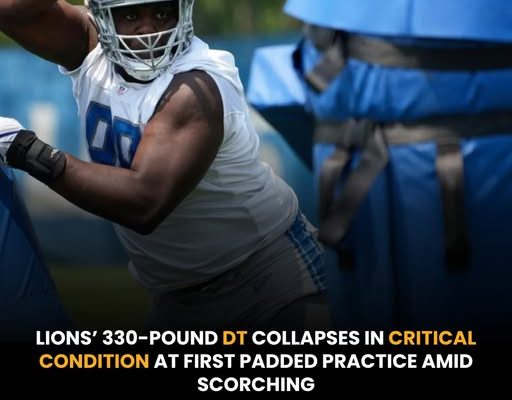The Detroit Lions were left reeling in shock during what was expected to be a routine first padded practice of training camp. On a sweltering summer day, where temperatures crept toward dangerous highs and heat advisories were being circulated throughout the state, tragedy struck when one of their largest and most physically imposing players suddenly collapsed on the field. The 330-pound defensive tackle, whose name has yet to be officially confirmed by team officials out of respect for his family and privacy protocols, went down midway through the session and was immediately surrounded by medical personnel. What had begun as an energized and promising kickoff to the team’s full-contact sessions quickly descended into a chilling silence that enveloped players, coaches, and staff alike.
According to eyewitness reports, the moment was abrupt. The lineman had been engaged in a series of full-contact drills in the trenches—a typical part of training camp designed to test not just physicality but also endurance and technique. He had just completed a rep and was preparing to line up again when he suddenly took a few uneasy steps backward and collapsed to the ground. The reaction from teammates was instant, with players immediately signaling to the training staff for assistance. Some dropped to their knees in concern while others huddled together, visibly shaken. Practice was immediately halted as trainers rushed to the player’s side and began administering aid.
Team medics reportedly initiated emergency protocols within seconds. Ice towels were applied, IV lines inserted, and hydration measures were increased as the staff attempted to cool the player’s body temperature and stabilize his condition. Paramedics were summoned from a standby ambulance unit stationed nearby—standard procedure during NFL practices—and within minutes, the player was being transported to a local hospital under emergency status. Early indicators suggest that the collapse may have been related to heat stroke or heat exhaustion, though an official diagnosis will likely await further medical evaluation.
The incident has not only sparked concern within the Lions’ organization but has also renewed a broader debate across the NFL about the risks of holding full-contact practices during periods of extreme heat. July and August often bring punishing temperatures across training sites, but the climate conditions in Detroit on the day in question were reportedly pushing beyond normal safety thresholds. Heat index values exceeded 100 degrees Fahrenheit during the late morning hours, prompting warnings from both meteorological services and medical professionals regarding the dangers of prolonged outdoor activity. Several teams around the league had already adjusted their practice schedules or moved indoors, but the Lions had opted to continue outdoors in Allen Park, relying on hydration protocols and built-in cooling breaks to mitigate the risk.
For the coaching staff, led by head coach Dan Campbell, the incident has struck a deeply emotional chord. Campbell, known for his gritty, passionate approach to football, was reportedly among the first to reach the player as he lay on the ground. Visibly distraught, he remained close throughout the emergency response, eventually addressing the team with a message of unity, resilience, and concern for their fallen teammate. Campbell is expected to speak to the media once more details are confirmed, but for now, the mood inside Lions’ camp is somber.
Fellow players, some of whom have known the defensive tackle since college or even high school, expressed their emotions in varied and powerful ways. Veteran leaders on the team, including Jared Goff and Aidan Hutchinson, requested to postpone scheduled media availability, choosing instead to spend time in team meetings and prayer circles. Social media was soon flooded with messages of support and well-wishes from across the NFL community. Former teammates, coaches, and rivals alike expressed their hope for a full recovery, and fans poured into online forums with heartfelt concern, praising the player’s tenacity, humility, and presence in the locker room.
The incident is not the first of its kind in professional football, but each occurrence carries its own gravity. The physical demands placed on linemen—particularly those whose body mass exceeds 300 pounds—are immense. When combined with extreme environmental stressors like heat, the results can be catastrophic. The NFL has made strides in recent years toward addressing heat-related illnesses, instituting mandatory breaks, hydration plans, and medical monitoring. However, critics argue that more must be done, especially as climate patterns continue to trend toward more extreme summer temperatures.
Some medical experts have long warned that players with high body mass indices are particularly susceptible to heat stress, especially when layered under heavy pads and helmets. In such conditions, the body’s natural cooling mechanisms can become overwhelmed, and core temperatures can rise rapidly to dangerous levels. Once heat stroke sets in, the window for effective intervention narrows dramatically. Rapid cooling and immediate medical treatment are essential to prevent long-term organ damage or worse.
The Lions have since released a brief official statement acknowledging the incident, confirming that the player remains in critical condition and is under round-the-clock care at a local intensive care unit. The team has canceled its next scheduled practice and closed the facility to the media out of an abundance of caution and respect. Mental health professionals have also been brought in to support teammates and staff as they process the traumatic events of the day.
As the situation continues to develop, attention has turned toward the player’s family, many of whom were reportedly not present at the practice but have since arrived at the hospital. The organization has pledged its full support, both emotionally and financially, in assisting the family during this difficult time. Several teammates have already begun organizing private visits, and team leaders have discussed holding a vigil or team gathering in solidarity.
This tragic event underscores the razor-thin line between preparation and peril in professional sports. While football is inherently physical, the added burden of environmental extremes introduces an unpredictable variable—one that demands constant vigilance. The hope now is that the player will recover fully and that this moment becomes a wake-up call not only for the Detroit Lions but for the league as a whole.
Even as the team awaits updates, the focus remains steadfast: recovery, reflection, and responsible reevaluation of safety standards. The Lions were a team on the rise heading into this season, widely considered playoff contenders with a young, energetic core and a city rallying behind them. But now, that momentum has taken a backseat to far more urgent concerns. Wins and losses suddenly feel trivial in the face of a life hanging in the balance.
Around the league, coaches and training staff are revisiting heat contingency plans and urging players to speak up if they feel any signs of distress. Conversations are being reignited about whether two-a-day practices, even modified, are still necessary in modern football. The NFL Players Association, always vigilant when it comes to player safety, has reportedly begun informal discussions about reviewing weather-related safety standards for training camps and preseason activities.
In recent years, the league has seen several close calls. Players at both the college and pro levels have suffered from heat stroke, some with lasting health consequences. The hope among all stakeholders is that this most recent case does not join those worst-case scenarios. Still, it serves as a stark and sobering reminder: the line between peak performance and a medical emergency can be crossed in seconds, especially when heat is involved.
For now, the Detroit Lions wait. Players have been encouraged to rest, to hydrate, and to lean on one another. Practice may resume in a few days, depending on how the situation unfolds, but it will likely never feel quite the same. The field that once hosted the sounds of shoulder pads clashing and voices rising in competition now holds a heavy stillness—a quiet that speaks volumes about the fragility of even the strongest among us.
As the football world holds its collective breath, all eyes remain on a hospital room in Detroit, where a young man who came to chase his NFL dream now fights the most important battle of his life. Whether or not he returns to the gridiron, he’s already earned the respect, admiration, and heartfelt support of an entire league and fanbase.



